Category Results:
How To Interview Anyone About Anything
Over the years my creative team and I have conducted hundreds of interviews for marketing films and videos. Not one of us had any kind of formal training in journalism; but, in the time-honored tradition of fake it ‘til you make it, we learned on the job, becoming better storytellers with each interview.
My first interview was with fashion icon Calvin Klein. CK was introducing their new fragrance Obsession, and my clients wanted Mr. Klein to share his vision for a launch event.
I prepared for the interview — not just by writing questions for him — but by writing questions for me. I asked myself:
- What if he doesn’t understand my question?
- What if he isn’t forthcoming in his answers?
- What do I do if I lose my train of thought?
Whether your interviewee is engaging or dull, surprising or predictable, or memorable or forgettable, is an outcome that can be greatly influenced by you. Pre-interview preparation and solid interviewing practices will make all the difference in the final product.
Here are seven tips we’ve learned from many hours of interviewing that help make our client videos and films come to life.
7 Tips for Conducting an Interview
Tip #1: Do your homework
You’ve heard the saying, “there are no stupid questions.” Well, those people are wrong. When it comes to doing interviews, there is such a thing as stupid questions. And if you ask them, you’ll be in for a short, awkward conversation.
Take the time to study up on both interviewee and subject. And stay organized by writing down your questions in a logical sequence, numbering them in the order you want to ask them.
Tip #2: Have a conversation, not a Q&A
I can’t stress this enough. Successful interviews are conversations. Conversations are about making a personal connection. Be sure to come prepared knowing some things about your interviewee to draw some points of connectivity.
What’s their alma mater, favorite sports team, or charity? What are they passionate about that you can use to energize the conversation? The truth is, as much as your client thinks their customer is in love with their product or service, they are more in love with what interests them.
Any conversation is two-way. If you can get your interviewee asking you questions, then you know they are primed and more likely to engage in the messaging that gets your client to say, “whoa, that was great.”
Tip #3: Know when to shut up
That said, be mindful to let the interviewee do most of the talking. Ask a question and then simply stop talking. And if your interviewee pauses, fight the urge to fill the silence or finish their sentence. Your main job is stay out of the way.
People like to talk about themselves and what they care about — and they’ll do it if you simply let them.
Tip #4: Shape the narrative
At Camp Creative, we conduct customer success interviews for online customer engagement.
We recommend keeping these kinds of videos short and we organize them in a narrative case study style (ie. problem, solution, resolution), which results in a pithy video usually about 2 to 3 minutes in length.
Interviewees are not made aware of this strategy in advance.
Letting them in on the strategic process may seem like a way to get a better interview, but we’ve found, in that case, interviewees are more likely to prepare long-winded statements that conform to a narrative that they think you want to hear. It’s your job to shape the narrative to fit the needs of the marketing story your client wants to tell — not the interviewee’s.
Guide the interviewee by thinking about what statements, or predicates you need to clarify the subject of your client’s message. When you get a response that feels rehearsed or canned, redirect the conversation with new questions that help shape the narrative from the point of view of your client.
Tip #5: Get the framing right
How your interviewee is framed is just as important as what they say.
Framing is an aesthetic choice that influences the look, feel, and tone of your finished video. And there are rules that guide where to place your subject within the aspect ratio for your frame. You may have heard of the rule of thirds, the golden ratio, or golden spiral.

Without getting too deep into theory, they are all ways to describe the mathematical principle involved in creating proportions that are most pleasing to the eye. This optimal framing can be achieved by placing your interview subject in roughly the left third of frame when they look left to right, as in this example:
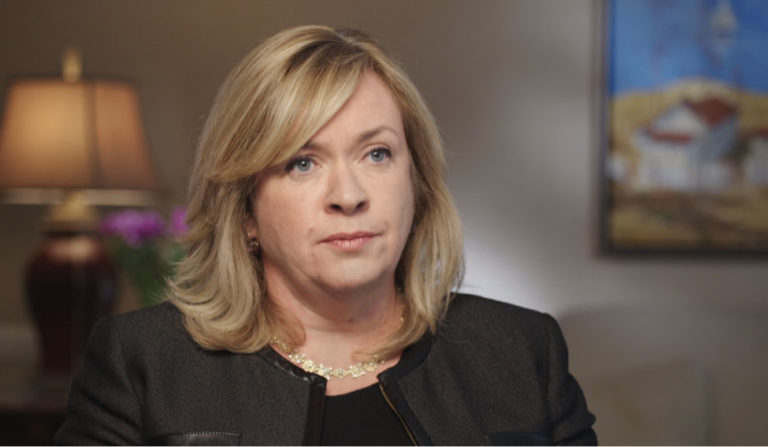
Or the right third of frame when looking right to left, as in this example:

Headroom, either too much or too little, is another consideration. I generally prefer just a little headroom, (see above), for wider frames, with a tighter “haircut” crop on close ups.
Now, let’s break the rules. In a recent shoot for Google, we ignored everything I just told you and centered subjects in the middle of the frame with ample headroom. Why? The subjects of this particular project are rebels, iconoclasts that buck the system and are breaking the conventional rules of the music industry.

Maybe this isn’t the right framing aesthetic for the CEO of a Fortune 500 company; but a break from the norm can add impact when the time is right.
Is your subject a rule breaker? Do they buck the trends? Think about what you know about your subject’s personality, and how it may translate into framing choices that add dimension to the narrative.
Tip #6: Be mindful of eye direction
Nothing bugs me more than sloppy editing that leaves a frame or two of eyes that are shifting away, right at the cut point.
Your subject’s body language can be just as revealing to viewers as what they actually say; and whether an editing mistake or not, eye shifts are a buzz kill for viewers that say, “you can’t trust me.”
How can an interviewer help prevent this kind of situation? By paying attention to eye direction. Eye direction is simply where you’ve got your subject looking as they speak. Interviews are usually conducted in either a more journalistic approach, with subjects looking off camera at the interviewer; or in the popular reality TV format of a confessional, with your subject looking directly into camera..
Direct eye contact with the viewer was perfected by documentarian Errol Morris in the late 80’s with his documentary, The Thin Blue Line. By placing a half silvered mirror at a 45 degree angle to the lens, the subject looks directly into the lens and the director at the same time.
There are a number of devices that make direct eye contact easier and cost effective. My favorite is Eye Direct. It’s available for rental at most camera houses or can be purchased.
Tip #7: Go ahead and wing it
Some of my best interviews have been with CEO’s of Fortune 100 companies. They are typically gifted communicators and comfortable in front of a camera.The CEO of Procter & Gamble AJ Lafley was no exception.
I had 30 minutes of his time for a networking company’s customer video success story. The interview began well, but his responses didn’t reveal anything different from any other P&G technology vendor. He was following the exhaustively vetted questions approved by our client. He wasn’t speaking from the heart.
When I realized this, I pivoted to open ended questions that explored the design of winning strategies and the mitigation of failure. I began to wing it.
As we explored the factors that produce good business outcomes, in this new format, his responses began to offer more insight. They conveyed more of what he wanted to talk about, instead of only what he was expected to talk about. This turned out to be a winning combination.
Incidentally, a few years later, the HBR published an interview with Mr. Lafley titled, I Think of My Failures as a Gift. Reading it a year after my interview, I realized that some of my “winging it” questions prompted answers that I felt failed to get a good response, led to better questions that ultimately succeeded.
Prepare and Practice to Interview Like a Journalist
Not being afraid of failing and knowing when to venture “off script” and just wing it takes some confidence and experience. But there may be, on occasion, extraneous circumstances where you literally have no other option. This is another reason why doing your homework is absolutely crucial.
Telling great stories through compelling interviewing is all about preparation and practice. (And it can often help to have strategic partners, too…) Following these seven tips is a good way to ensure you and your interviewee get the most out of the experience.
UX Design: Humanizing The Digital Experience
UX DESIGN GUIDES WEBSITE VISITORS
Bay Alarm is a leading provider of security systems for residential homes and businesses in California. Family owned since 1946, Bay Alarm is known for high-quality service and support. In an industry with a high employee turnover rate, Bay Alarm prides themselves in retaining highly trained employees that stay with the company on average over 10 years. Surprisingly, the Bay Alarm website was a reflection of their success. The focus on face-to-face customer service and support was strong. However, the fundamentals of good UX design needed improvement. It was hard to find information about security topics and alarm system solutions for residential and business visitors were buried deep within the site.

The original website reflected a one dimensional message.
THE CHALLENGE
Bay Alarm’s lead generation and knowledge sharing needed a fresh strategy. Working with Camp Media Arts, a holistic digital marketing agency with solid web application development and inbound marketing success, Bay Alarm recognized that the website could perform better.
Camp Creative/Camp Media Arts brought on UX design and strategy specialist, Daniel Castro, to lead a design thinking exercise and a UX design workshop.
Our goal for bayalarm.com: reflect the premium service that thousands of happy customers experienced, generate sales leads and provide a richer knowledge base to help visitors make informed decisions.
THE SOLUTION
Don’t Forget There’s a Human Behind the Screen
The human experience: Any digital effort that a brand undertakes, needs to reflect the basic wants, needs and fears of real people as they experience their service. Those are our UX design guiding principles. Our approach gave us insight into digital touch points with “brick and mortar” touch points such as call centers, or support.
Bringing the client and agency team together, we conducted an in-depth customer journey workshop. We drew our inspiration from several popular customer journey/service map tools created by Jakob Schneider & Marc Stickdorn and the Business Model Canvas by Strategyzer.
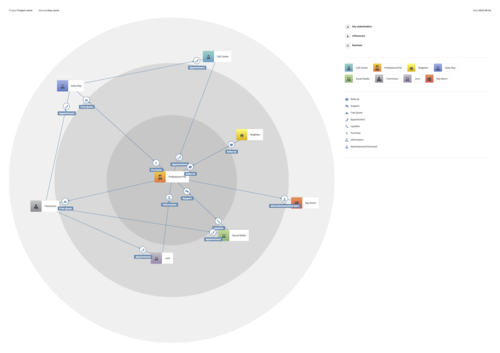
Bay Alarm Stakeholder Map
To understand what drives and motivates potential buyers of home alarm systems, we walked in their shoes for one day. As they first set out to contact Bay Alarm (via social media, direct response to a campaign, or word of mouth), the CMA and Bay Alarm teams joined together to follow the customer journey—from purchase to after-sale support. It was a fun and eye-opening exercise, even for long-time Bay Alarm employees. This journey became our compass for the content and overall design of the website.
Next, we created a persona based stakeholder service map. Bay Alarm has two primary markets, (business and residential) and each market had its own set of personas. We focused on the primary two personas since the stakeholders did not really change. This gave us a clear sense of possible gaps that existed and provided better visibility into potential opportunities in the future.
A Living Breathing Digital Ecosystem
Our UX strategist Daniel’s most important role was supporting the effort to educate the client. For example, the importance of seeing the website as a part of a whole “digital ecosystem” is often overlooked. Building a website in the traditional sense and leaving it until trends in design demanded a change, is a thing of the past. Customers and potential customers are digitally connected all day and expect that brands adapt to them. This means that a “redesign” is only the beginning and should be viewed as a collection of digital services that amplify each other. Testing played a major role in our design process. We ran several qualitative tests to ensure the collection of data supported hypotheses we made and provided insight for future iterations of the website.
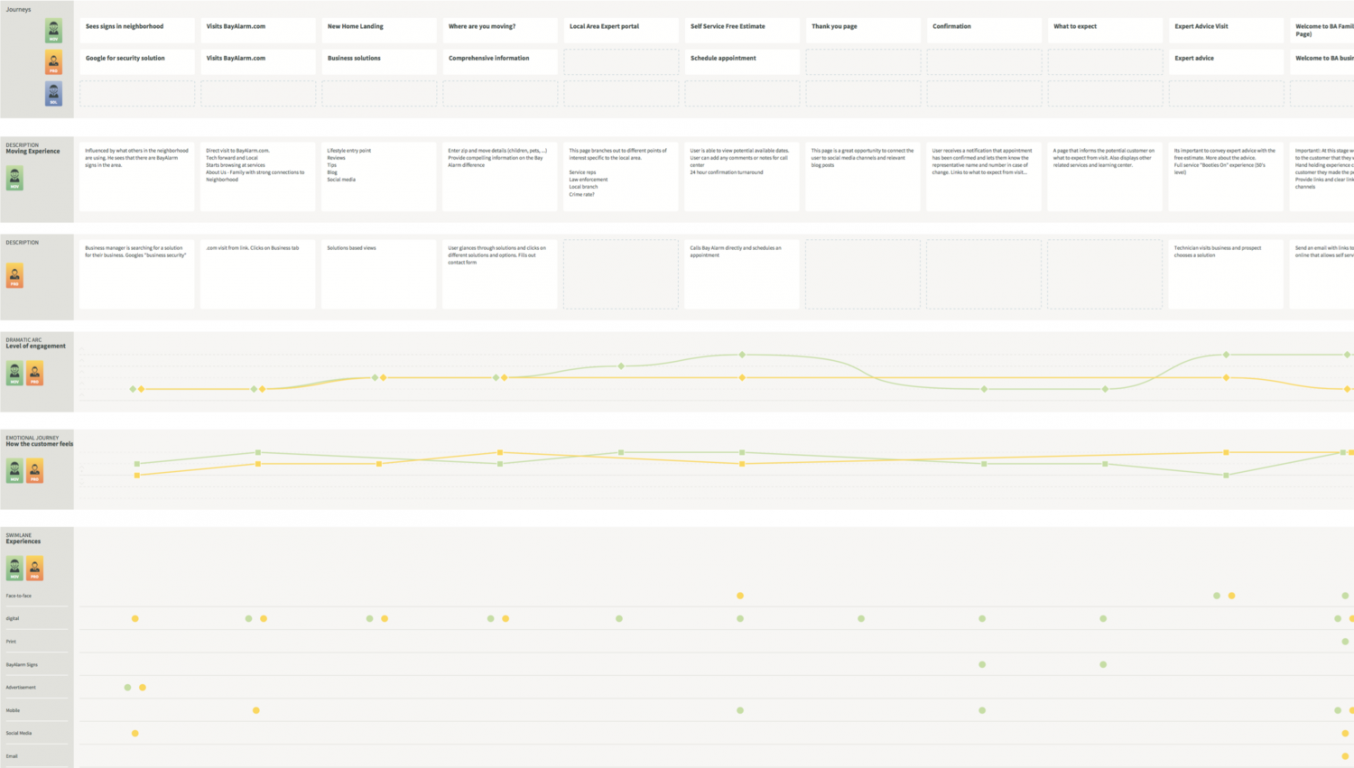
The Customer Journey
Mental Models
We conducted interviews to see what existing and potential customers thought about residential and home security. We discovered a strong correlation between major life events and the concern for security, monitoring, or general curiosity around technology options. This guided us in designing a site information architecture that mapped mental models of visitors as they experienced different stages of engagement.

Mental models help us understand how people think.
Putting It All Together
– Content is everything.
– Optimize for “scanning” behavior.
– Don’t make users think too hard.
– Clear call to actions with minimal user input.
– Simplicity. Allow the content to shine through minimalism.
– Clear sense of hierarchy (the mind likes simple structure).
– Low cognitive load via white space and reduction of unnecessary “noise”.
– Test your designs.
A Sophisticated and Caring Neighbor
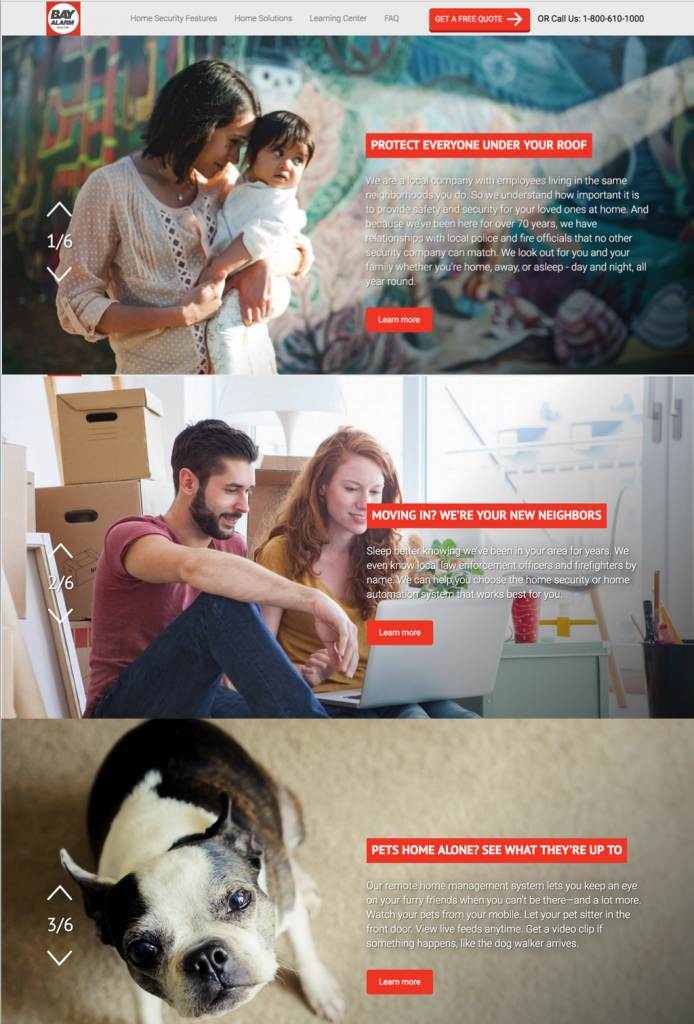
Customers chose Bay Alarm based on word of mouth, or because they saw the signs in the neighborhood. Customers also liked that Bay Alarm was a local California company. The information architecture and the design reflected this mindset, and our design reflected a “premium” voice and service. We removed information clutter and promotions that encourage customers to make informed choices to meet their goals.
Life events and lifestyles were featured as clear entry points for relevant content and services. Visual cues supported the idea that Bay Alarm was a ‘local company’ that cared for the neighborhood. The site displays beautiful scenic images of the local area that the visitor is viewing from LA, SF, San Diego and throughout their California service areas. Local branches display pictures of the local managers and contact information of the local branch. All these details tied nicely with the design choices for a visually rich and relatable imagery.
RESULTS
Initial user testing was very positive. Words such as “professional”, “appealing”, “care”, “get it” and others were used to describe the site. Visitors liked the aesthetic balance of content. The lifestyle approach was well received.
These results were similar for both residential as well as business! We’re happy to validate the advance effort and research required prior to the actual designs phases. This reflects the dedication and belief by Bay Alarm that these investments pay off in a better experience for customers. Since the site has gone live, leads are up over 400% and other conversion rates, and web statistics are trending up significantly. Check out bayalarm.com here!
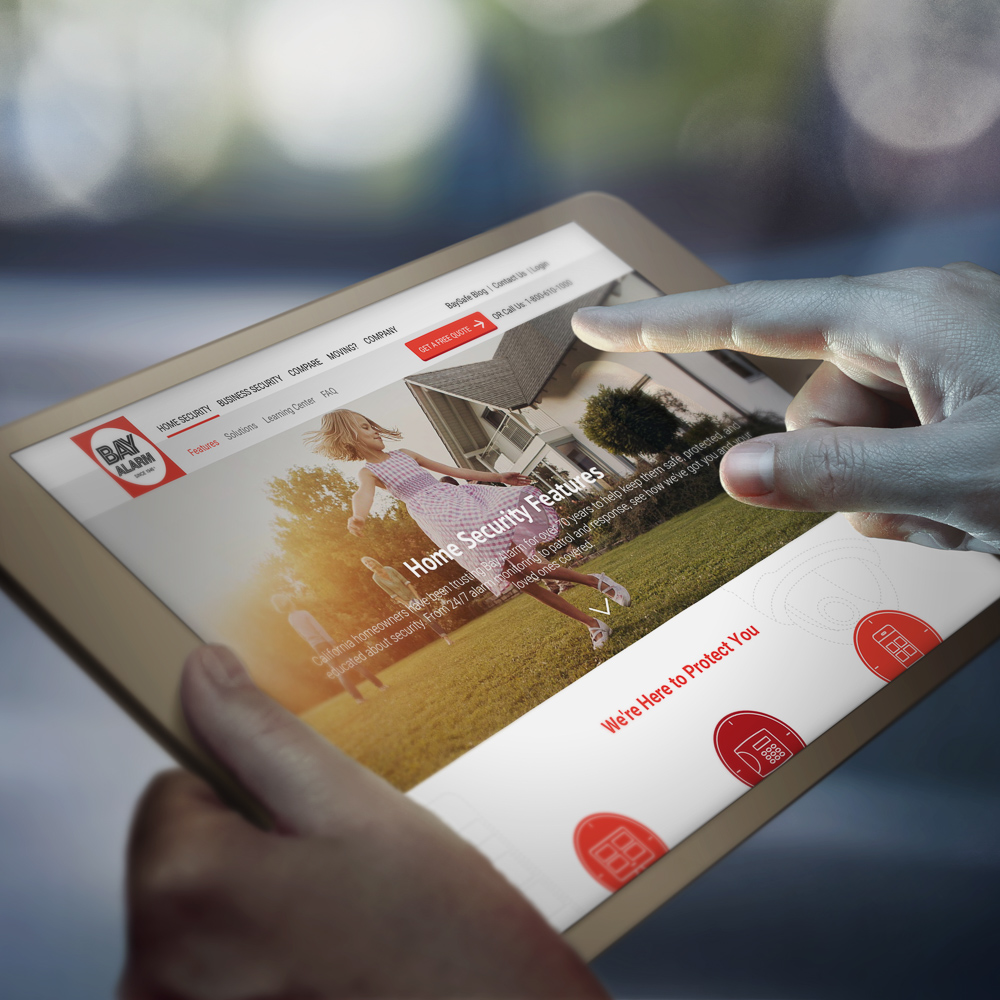
CREDITS
Agency: Camp Creative
Creative Director: Richard L.Camp
Developer: Mike Hatfield
Project Management: Mike Stevens, Jamie King
UX Design Strategy/Information Architecture: Daniel Castro
Visual Design: Jordan Camp, Kevin Wong, Carolina Escobar
Copywriters: Bruce Tallerman, Karen Goldfarb
SEO: Jackie Richmond
Lead Workflows: Chuck Jones
Content Integration: Paula Stone
Tips for Crafting a First-Rate LinkedIn Company Page
Your LinkedIn company page is a unique space on the web: both prospective customers and employees are likely to visit. As a sales channel and recruiting channel, its an online touch point you can’t ignore! That’s why we’ve put together a Visual Guide to Crafting the Perfect LinkedIn Company Page. In this guide you’ll find pro tips and best practices for creating and maintaining a LinkedIn company page, as well as Photoshop and Powerpoint templates for designing banner images, icons, and so on.

SEO Tips and SEO Mistakes to Avoid in a Website Relaunch
Relaunching a website is a fun and exciting process. Whether part of an overall brand refresh, or simply updating an outdated relic, a website relaunch offers a great opportunity to give your brand a more appealing digital presence and boost your lead generation efforts.
A very common mistake organizations make during a website relaunch initiative is excluding search engine optimization (SEO) from the outset. It’s easy to get wrapped up in the visual design and aesthetics of a new site, but designing a beautiful site without incorporating SEO is like buying a new car with an amazing paint job but no engine. Make sure your new site is is as functional as it is beautiful!

…should have looked under the hood.
A surprising number of website design firms are focused on design only, and do not incorporate SEO into their efforts. All too often, those tasked with a website relaunch are new to the process, and are trusting design firms as subject matter experts to deliver the best results. These firms deliver on exactly what they are contracted to do: design and deploy an aesthetically pleasing website, NOT a site that will perform well in search results. Only months later when site traffic has plummeted and bounce rates are through the roof is the question asked, “Is our flashy new site search engine friendly?” The whole experience is like buying a used car off of Craigslist that breaks down right after you buy it.
So how do you avoid a ‘lemon’ with your website relaunch? Here’s a start:
- Incorporate SEO strategy from the very beginning of your website initiative. If engaging with a design firm, ask them directly how they incorporate SEO into their process before a contract is in place.
- Do keyword research and develop a content strategy with your buyer personas in mind. This affects everything: site menus, URL structure, page content, and so on.
- Look at your competitors and how they are ranking for search terms. Evaluate what you want to rank for and how your site content will rank for those terms.
There’s many factors to consider when doing SEO for a site relaunch, so we’ve created a free E-book full of SEO tips to make sure you avoid the common pitfalls: “10 SEO Mistakes to Avoid During Your Next Website Redesign.”

A Complete Guide to Facebook Ad Specs
When done right, running paid search campaigns on Facebook can yield great results, whether you’re looking to increase leads, boost page likes, or some other type of conversion. However, one of the ongoing challenges is keeping track of all the current ad specifications and rules you must follow to run a campaign. Fortunately we’ve found 2 resources to help make the process easier.
First, the folks over at Salesforce.com have compiled this brilliant infographic and slide deck that shows all the different Facebook ad specs. (Source: Salesforce Blog) It contains all you need to know about the different ad formats on Facebook:
Next up, this online tool create by socialcontests.com gives you an easy way to audit your ad’s text content to ensure it passes Facebook’s “no more than 20% text” rule.
Getting your ad’s image rejected by Facebook is an unnecessary waste of time. Use this tool to ensure your ad is approved the first time, every time.
19 Spring Cleaning Tips for Better Marketing Optimization
 Spring is in full swing, and with it the whole idea of spring cleaning is top of mind. We’ve been talking around the Camp Creative lunch table about the bestselling book, “The Life Changing Art of Tidying Up” from Marie Kondo. Her promise of “…living a clutter-free life forever more” is pretty appealing so some of us are trying her methods, to varying degrees of success. For example, I love the idea of getting rid of clothes that no longer fit but still find the blissful state of knick-knack-free nirvana a little elusive.
Spring is in full swing, and with it the whole idea of spring cleaning is top of mind. We’ve been talking around the Camp Creative lunch table about the bestselling book, “The Life Changing Art of Tidying Up” from Marie Kondo. Her promise of “…living a clutter-free life forever more” is pretty appealing so some of us are trying her methods, to varying degrees of success. For example, I love the idea of getting rid of clothes that no longer fit but still find the blissful state of knick-knack-free nirvana a little elusive.
Regardless, this whole idea of decluttering got me to thinking; us marketers probably have plenty of clutter we can purge. Best practices that we should follow get lost in the shuffle of our everyday hustle and bustle. And in the process our tidy marketing efforts are less efficient — and productive — than they could be. So I’ve put together this list of 18 spring cleaning tips for marketers. Now that the craziness of conferences like SXSW has subsided, its time to do some spring cleaning!
Now, we work with a whole range of companies, from 2-person startups to Fortune 100 companies. So, some of these marketing optimization tips may not apply, especially if you’re in a larger organization with a more focused set of responsibilities.
Tips for CRM and Marketing Automation Platforms
Remove duplicate records from your CRM.
Duplicate entries can cause a whole ton of problems with CRM software. Whether it’s a lazy sales team entering data or improperly configured lead capture forms, there are many ways for duplicate records to creep into your CRM. If you’ve never run a dedupe, or if its been awhile since your last one, do yourself a favor and run an audit on your database for duplicate records. You may be surprised at what you find!
 There are a lot of vendors that provide dedupe software for just about every CRM out there. If you can’t find the budget for an ongoing license, see if you can run an initial dedupe with a free trial.
There are a lot of vendors that provide dedupe software for just about every CRM out there. If you can’t find the budget for an ongoing license, see if you can run an initial dedupe with a free trial.
Remove any obvious bad data or bad leads from your CRM.
Similar to running a dedupe, do some searches in your database for leads who have the first or last name value of, “Test,” or “asdf,” or similar garbage values that can be removed. Cleaning out junk records like this will improve the accuracy of your overall reporting.
Audit your lead database for improperly capitalized records.
Sometimes leads will get entered with improper capitalization of the first name or last name field. For example, “John Smith” gets entered in as “john SMITH.” Leaving these records improperly formatted can make you look a little silly in your email marketing if you use personalization tokens with your emails.
For example, using personalization in an outbound email campaign with this lead record might produce a subject line like this:
 “Hey john! Check out our latest white paper…”
“Hey john! Check out our latest white paper…”
“Hello Mr. SMITH, check out Booth 465 at this trade show…”
“Good Afternoon JOHN…”
It’s AWKWARD. I mean, it’s awkward.
Fortunately, there’s a quick and easy fix: export your data to an Excel sheet, and then use the “PROPER” function to correct everything. You can fix your entire database in under 10 minutes. Then, upload your spreadsheet and append your lead records. Voilà! Once you’ve run this update you can rest assured that your personalized emails don’t look like a 6th grader’s text message. (Check out instructions on Excel’s “PROPER” function here.)
Audit your lead scoring system in your marketing automation tool with some real sales info.
If you are using a marketing automation platform, odds are you are using lead scoring for your nurture campaigns. The thing about these systems is, they are never one-size-fits all. Every lead scoring system has to be customized to a particular company’s needs. If your system has been up and running for a while, the reality of your lead scoring requirements might be different from your initial assumptions during setup.
Take a sample of actual deals that closed, and trace them back to the top of the funnel to their first touch point. For each lead, look at how their lead score accrued as they progressed through your sales funnel, and ask yourself if your scoring system still makes sense. Should they have been upgraded to a marketing qualified lead sooner? Later? Should someone on your sales or marketing team received a notification about some activity that this lead did? Odds are, you will have some adjustments to make with the nuts and bolts of your lead scoring system.
Audit your report and dashboard setup.
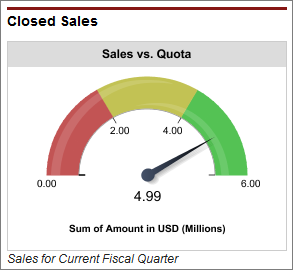
Think about how your team is using your CRM and/or marketing automation platform. Do your reporting templates meet your needs? Does the dashboard/user interface deserve any customization that you may have missed on initial setup? A slight adjustment in the UI might drastically improve your team’s productivity.
Archive outdated landing pages and set up 301 redirects.
If you have landing pages for expired offers, consider archiving them and setting up 301 redirects. For example, if you have a landing page for an offer specific to a trade show from 2014, setup a redirect to the landing page for the 2015 event’s landing page.
Tips for Sales and Marketing Collaboration
Talk to your sales team about what’s working and what isn’t.
Streamlined organizations often have this built into their processes, so this may seem like stating the obvious. But its important so I’ll say it anyways. Go talk to your sales team and ask them what is working! What type of marketing assets do they need more of? What is helping them close deals? What is extraneous? What kind of leads are getting the best response and close rates?
Also, make sure you talk to people at varying levels of the sales organization. Talk to sales execs, inside sales reps, sales development reps, and so on. If there is a sales operations person(s) in your organization, talk to them as well. Your sales ops team might be able to provide you with hard data on what marketing collateral is getting used the most.
 Review your buyer personas and see if they still ring true.
Review your buyer personas and see if they still ring true.
Buyer personas are always evolving. Review your personas with your sales team and see if they still make sense. Do any personas need adjusting? Are any missing? Which personas are driving the most revenue?
Tie off any loose ends with old projects.
Projects get put on hold all the time for a myriad of reasons. Look at your list and see if anything should be revisited or wrapped up. Sometimes reaching out about old projects can lead to new projects for your pipeline.
Tips for Website and Online Presence
 Check your website load time.
Check your website load time.
A slowly loading website can send your bounce rates through the roof. Your site may have been optimized when you first launched it, but any number of factors might have changed since then, affecting your page load times. Check your page load time using a free tool like ping-dom or webpagetest.org.
Check up on your Google Analytics.
If you are involved in your company’s website, you are likely doing this as a regular part of your routine. However, at smaller organizations like startups, oftentimes marketers are so overwhelmed with their to-do list, looking at web analytics gets lost in the fray. Take a look at your your heat maps, bounce rates, traffic trends, and so on.
Review your site in Google Webmaster Tools.
Its always good to know how Google sees your site. Go to your Webmaster tools account and audit/update your XML sitemaps, check for any 404 errors, test your robots.txt file, and given the “Mobilegeddon” update of April 2015, double check the Mobile Usability dashboard. (And if you haven’t heard of Mobilegeddon yet and your site isn’t mobile friendly, I encourage you to read this immediately.)
Check your site in search.
Do searches for your company name in Google and Bing. Find out where you stand in branded search.
Check your competitors’ sites in search.
Where do your competitors stand in their branded search?
Check search engine results for your targeted keywords.
What keyword strings are you ranking well for? What do your competitors rank well for? What are you up against?
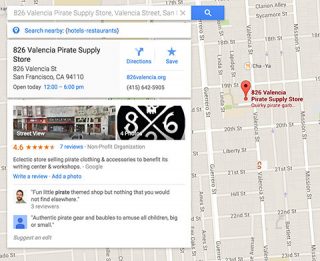
These pirates are on top of their SEO game.
Check your company info in Google Maps and Google+.
It may have been a while since you last checked your Google Maps listing. Not too long ago, Google released “Google My Business” as an easy way to keep your listings up to date. Keeping this information up to date is critical for two reasons. First, your customers know how to find you. The second reason is that you will get a nice SEO boost as a result. (For details on the SEO component of Google+, check out these posts on Social Media Examiner and Moz.)
Check your Yelp listing.
You may be thinking, “I don’t work for the kind of company that is on Yelp.” Even so, someone else may have added your listing without your knowledge. (For example, if someone “checks in” at your office during a job interview.) Take a look at your listing and make sure everything is in order. If you don’t have a listing, create one. This is low hanging fruit for an easy SEO boost.
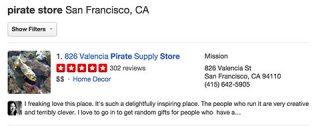
Even swashbucklers use Yelp!
Check in on your social media accounts.
This is going to vary widely from person to person and company to company, but here’s some ideas on what this ‘check-in’ could mean. Is all your profile information current and aligned with the rest of your online presence? If you don’t manage your company’s social account, is the person managing your account doing so effectively? Is he or she clear on the strategy, and what their performance metrics are? Has your social media effort made any contributions to your lead generation? Have there been any negative incidents on social media? If so, are those incidents being handled/managed effectively?
Check your site search functionality.
Check your site’s search feature
If your website has a search feature, put yourself in a customer’s shoes and do a few test searches based on terms they would use. Does the right information pop up in the results?
Do you have any good spring cleaning tips for your marketing programs? Let me know in the comments or message me on twitter @chucktothejones. Happy cleaning!
New Paradigms: Build Your Website for Lead Generation
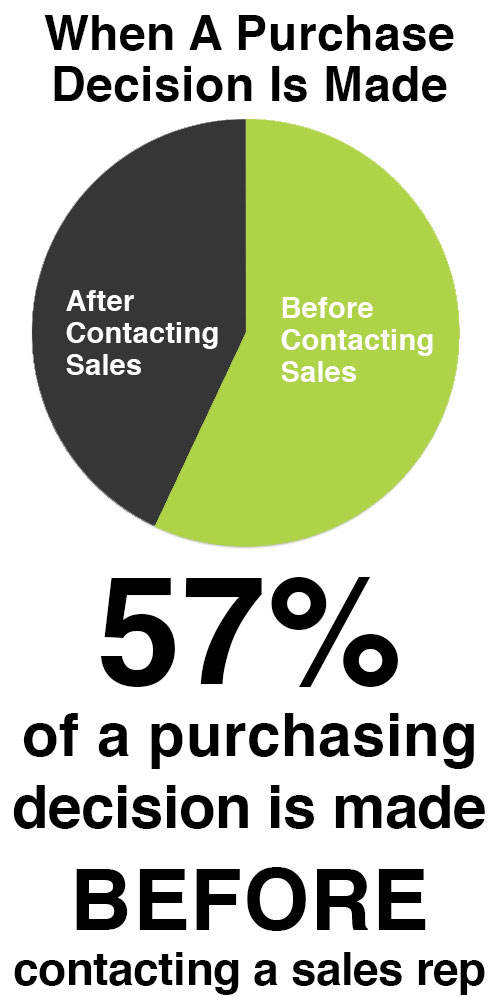 A few years ago, Harvard Business Review published an article with a single statistic that stands out in my mind as the most poignant and relevant data point for the current digital marketing strategy landscape. Although published in 2012, I still see this stat referenced constantly on Twitter, blogs, and at marketing conferences:
A few years ago, Harvard Business Review published an article with a single statistic that stands out in my mind as the most poignant and relevant data point for the current digital marketing strategy landscape. Although published in 2012, I still see this stat referenced constantly on Twitter, blogs, and at marketing conferences:
“A recent Corporate Executive Board study of more than 1,400 B2B customers found that those customers completed, on average, nearly 60% of a typical purchasing decision—researching solutions, ranking options, setting requirements, benchmarking pricing, and so on—before even having a conversation with a supplier. In this world the celebrated “solution sales rep” can be more of an annoyance than an asset. Customers in an array of industries, from IT to insurance to business process outsourcing, are often way ahead of the salespeople who are “helping” them.”
(Sources: Harvard Business Review & CEB)
Let that sink in for a second. Today, buyers have their decision mostly made before they have any conversation with your sales team. The article is appropriately titled, “The End of Solution Sales,” and makes the case that, “boosting the performance of average salespeople isn’t a matter of improving how they currently sell; it involves altogether changing how they sell.” How your sales team should adapt is something I’ll explore further in another post. What I’d like to focus on is what this means for your website.
This shift in buyer behavior means that now more than ever, your website is a critical component in the sales process. It is the public face of your company, and is often the first thing a potential customer will see when considering your product or service. Granted, every online touch point is important, social media or otherwise, but your company’s site serves as the central hub for potential customers as they go through their purchase decision process.
The good news is, you can make this shift in buyer behavior work to your advantage. Your company’s website can be turned into a lead generation machine, attracting traffic, converting unknown traffic to leads, and nurturing leads into customers. To do this, your website should incorporate the following:
 Get found online with search engine optimization (SEO). Make sure that your website is playing nice with Google. This includes a combination of on-page optimization and off-page efforts. A well-optimized site will appear higher in search engine results pages (SERPs). The top result in a Google search typically gets 36.4% of clicks.
Get found online with search engine optimization (SEO). Make sure that your website is playing nice with Google. This includes a combination of on-page optimization and off-page efforts. A well-optimized site will appear higher in search engine results pages (SERPs). The top result in a Google search typically gets 36.4% of clicks.
Make sure your site is designed for usability. Most sites in most industries have a 30-60% bounce rate, meaning that visitors come to a site and immediately leave. Sites that are designed for usability ensure that traffic that visits the page stays on the page, lowering bounce rates.
 Get the right content on the site. Having content that is relevant and useful to your site’s visitors is an absolute must-have for your website to generate leads.
Get the right content on the site. Having content that is relevant and useful to your site’s visitors is an absolute must-have for your website to generate leads.
Make sure you can convert traffic to leads. Once an anonymous visitor comes to your site, make sure that your site enables them to provide their information and become a lead that you can nurture. This is typically done through call-to-action buttons and javascript-based lead capture forms.
For an in depth look at turning your website into a lead generation machine, check out our Ebook, “25 Essential Website Elements to Drive Traffic, Leads, and Sales.”![]()
Get To Know The Marketing Metrics That Matter
These days as marketers, we are flooded with metrics. Website traffic. Bounce Rates. Followers. Likes. Conversion rates. The list goes on and on. With so many marketing metrics its easy to lose perspective on what metrics really matter: the ones that show marketing’s contribution to the bottom line. When presenting to C-level executives, marketers should focus on those metrics that demonstrate ROI.
One key metric for marketers is a company’s Customer Acquisition Cost (CAC). The CAC shows how much a company is spending to get a new customer. It is calculated by taking the overall sales and marketing cost and dividing that figure by the number of new customers acquired in a given month.
For example:
Sales and marketing cost: $100,000
New customers acquired in a month: 10
CAC = $100,000 ÷ 10 = $10,000 per customer
An increase in CAC means that new customers are costing you more, which may indicate a problem with your sales or marketing efficiency. Imagine how happy your boss will be when you can provide hard numbers on sales and marketing efficiency!
To learn more about the marketing metrics that have real meaning for C-level executives, download our Ebook, “6 Marketing Metrics That Your Boss Actually Cares About.”
Forget Big Data, Get Smart Data – Market Research for Real Insight
Futurist John Naisbitt once said,
“We are drowning in information
but starved for knowledge.”
In today’s world of big data, this is especially true. As marketers, we are often overwhelmed with data but lack real, actionable insight. How can one cut through the noise of information overload and get to the real, actionable insights that matter? And once you have that insight, how do you effectively communicate it to your audience?
We’ve teamed up with market research experts The Connell Group on a webinar to answer these questions. In this webinar, we’ll address:
- How to extract actionable insights from your market research or data sets
- How to convert those insights into compelling content
- Criteria for how to communicate your insight to your audience, whether its through data visualization, websites, social media, video or some other medium
How a Common Hollywood Screenwriting Technique Can Transform Your Marketing – Part 3 of 3: The Hero’s Journey For Brands
In my previous posts, I argued that telling stories is the most effective way to market your product or service. I also outlined the history of The Hero’s Journey narrative framework and how Hollywood has used it for years to craft blockbuster story lines. In this post we’ll look at how The Hero’s Journey can be leveraged for your brand.
For your marketing efforts, you can use Joseph Campbell’s, ‘Hero’s Journey’ framework to create compelling stories around your product or service. To review, here is a diagram of that framework.

The key to using the framework in a marketing context is to place your customer into the role of the Hero, and your product or service takes in the role of the Mentor. Once you do this, your marketing story starts to take shape. Whether you are working on a product launch with many marketing touch points or scripting your next marketing video, the ‘Hero’s Journey for Brands’ can help. Obviously this is not a panacea for every piece of marketing collateral you create, but a surprising number of assets can be created or enhanced with this framework.
We use this framework so much in the work we do for our clients that we have created an abbreviated version of the Hero’s Journey specific to content marketing. Our abbreviated steps are:
The Hero’s Journey For Brands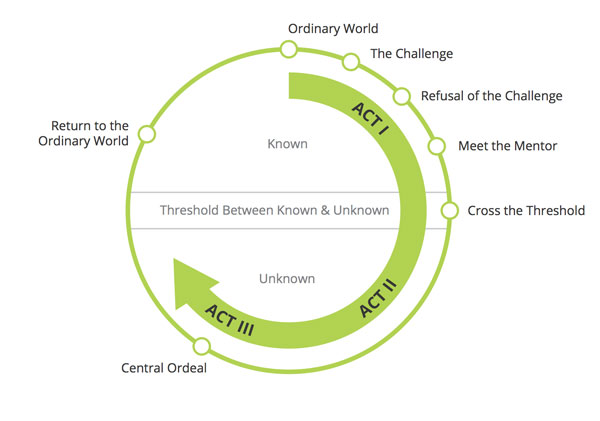
- Ordinary World – We see the Hero in his or her ordinary world.
- The Challenge – We identify the Hero’s need or problem.
- Refusal of the Challenge – They hesitate because change isn’t easy.
- Meet the Mentor – They are introduced to your brand’s value proposition.
- Cross the Threshold – The Hero takes the leap of faith, possibly due to some proof point you can offer.
- Central Ordeal – They agree to adopt/use your product or service.
- The Return – The Hero returns to their ordinary world, their challenge resolved with the help of your product or service.
Ready to put it into practice? We’ve created a PDF worksheet for you to apply the framework to your product or service. To learn more about the ‘Hero’s Journey’ and access the worksheet, download our free E-book:
Or, watch our archived webinar:
How a Common Hollywood Screenwriting Technique Can Transform Your Marketing – Part 2 of 3: The Hero’s Journey
In my previous post, I made the case that marketers are more effective when telling stories because it satisfies a fundamental human desire. In this post we’ll take a look at the history of The Hero’s Journey’s narrative framework.
Story telling predates writing; it has been with us since the dawn of humanity. However, it’s only relatively recently that anyone explored how or why we need to tell stories. At the beginning of the 20th century, Sigmund Freud and Carl Jung were pioneering the field of psychology and uncovered important truths about the human psyche; storytelling gives the present meaning and helps make sense of the world we live in. They introduced the concepts of a collective unconscious and archetypes.

In the 1930’s and 40’s a professor at Sarah Lawrence College named Joseph Campbell taught an introductory course on mythology. His research led to the publication of The Hero With a Thousand Faces, a treatise on storytelling across cultures. Influenced by many of Jung’s ideas, Campbell’s research showed similarities in mythology across cultures. He claimed that these myths are actually different versions of one underlying eternal theme, which he called the ‘mono myth.’ In the mono myth, there is a hero character that goes on a journey, encountering several archetypical characters along the way.
Here are the steps of the Hero’s Journey outlined by Campbell:
- Ordinary World – The Hero begins in an unremarkable world of normalcy.
- Call to Adventure – Our Hero receives a call to head off into the unknown.
- Refusal of the Call – Frequently, the Hero is reluctant to answer the call. This could be due to fear, insecurity, or other reasons.
- Meet the Mentor – The Hero meets a supernatural or spiritual guide.
- Cross the Threshold – This is the point where the Hero crosses from his/her ordinary world into the unknown.
- Tests, Allies, Enemies – The Hero must endure a series of tests or challenges to begin their transformation.
- Approach – Setbacks occur, sometimes causing the Hero to try a new approach or adopt new ideas.
- Central Ordeal – The Hero encounters a major obstacle or hurdle.
- The Reward – The Hero survives death, and earns a reward or accomplishes his/her goal.
- The Road Back – The Hero begins his/her way back to their ordinary world.
- Resurrection – A final test, where the Hero must summon all of his/her knowledge.
- Return With the Elixir – The Hero returns home and applies their new found knowledge or power.
Without meaning to, Joseph Campbell wrote a how-to guide for screenwriters. The Hero With A Thousand Faces became tremendously influential for Hollywood writers who employed the framework to craft plot lines, most notably with George Lucas and Star Wars. In fact, George Lucas claims that without Joseph Campbell, he would “…still be writing Star Wars today.”
Watch a young George Lucas give thanks to Joseph Campbell:
What does this look like in practice? Here’s how Star Wars maps to the Hero’s Journey:
- Ordinary World – Luke at home
- Call to Adventure – Leia’s message
- Refusal of the Call – Luke can’t leave because he has to help with the harvest
- Meet the Mentor – Obi-wan rescues Luke from the sand people
- Cross the Threshold – Luke escapes Tatooine
- Tests, Allies, Enemies – Lightsaber practice, Han and Chewie, stormtroopers
- Approach – Luke and allies move towards the Death Star
- Central Ordeal – They free the Princess
- The Reward – They capture the Death Star schematics
- The Road Back – Death Star has moved closer to the Rebel camp
- Resurrection – Luke destroys the Death Star by sacrificing part of his old self (his dependence on machines)
- Return With the Elixir – They are rewarded with medals
Today, the Hero’s Journey framework is everywhere. It is so prevalent in Hollywood blockbusters that it is difficult to find a large studio backed film that doesn’t follow the Hero’s Journey closely. Films like The Matrix, Finding Nemo, The Incredibles, and many, many, more all map closely to Campbell’s framework.
Read the next post, “How a Common Hollywood Screenwriting Technique Can Transform Your Marketing – Part 3 of 3: The Hero’s Journey For Brands.” (coming soon)
If you’d like to learn about the Hero’s Journey and how it can help your brand, download our free ebook here:
Or, watch our archived webinar:
How a Common Hollywood Screenwriting Technique Can Transform Your Marketing – Part 1 of 3: The Content Marketing Dilemma
In this three part series, I’ll examine how marketers are increasingly tasked with creating quality content. I’ll define and outline a narrative framework called ‘The Hero’s Journey,’ and how you can use it to improve your content marketing efforts.
Let’s face it, traditional marketing is dead. Or, at minimum it’s on life support. Content marketing – creating, curating and sharing relevant information and ideas with your customers – is the new normal. The key word here is relevant. When you share knowledge that resonates with consumers you’ve given them a real reason to seek you out and engage with your brand. You have a unique insight or knowledge set. Share it with customers (and potential customers) and you’ve made an investment that can help shape your brand’s perception and define your customer relationships.
If you’re currently engaged in content marketing and find that your content is increasingly ignored ask yourself, is the content too bland to ignite any real interest or too similar to other content to garner attention? There are millions of tweets and blog posts, each proclaiming that ‘quality content is king,’ (and they aren’t wrong). But too few tell you how to improve your content to make it eye-catching, interesting, relevant, and share-worthy. The marketer’s dilemma is then, “How can I consistently create quality content that my customers want to engage with?”
 This contemporary problem can be solved with one of the oldest crafts known to humans, the art of story telling. Specifically, we think the framework of The Hero’s Journey is the perfect structure upon which to build your brand’s story. Ok, ok… I know… you’re probably rolling your eyes right now thinking that this is some solipsistic “liberal arts” nonsense. “What does storytelling have to do with marketing?” The short answer is, “Everything,” but first, let’s take a step back and look at the economic power of storytelling.
This contemporary problem can be solved with one of the oldest crafts known to humans, the art of story telling. Specifically, we think the framework of The Hero’s Journey is the perfect structure upon which to build your brand’s story. Ok, ok… I know… you’re probably rolling your eyes right now thinking that this is some solipsistic “liberal arts” nonsense. “What does storytelling have to do with marketing?” The short answer is, “Everything,” but first, let’s take a step back and look at the economic power of storytelling.
According to the US Department of Commerce, the film industry took in $31 Billion in domestic revenues in 2013. Worldwide, the video game market surpassed $93 Billion during the same period. The US publishing industry took in $27 Billion in 2013. Worldwide, people spend hundreds of billions of dollars to read, watch, or listen to stories in movies, television, books, magazines, newspapers, websites, and so on. The ‘story industry’ is a major force in the global economy.
Harry Potter, World of Warcraft, Real Housewives of Atlanta, and a how-to video on your website have very little in common. Except, each taps into the most basic of human desires; the need to hear and share stories. Savvy marketers realize that pushing product features and benefits aren’t going to cut it any more. They create stories that bring those features and benefits to life and follow the classic creative writing rule of, “show not tell.”
So, if we accept the premise that your marketing can be improved through story telling, how can you make a marketing story pop? This is where the Hero’s Journey framework comes in. What is the Hero’s Journey framework? Stay with me now… we’re taking an elevator straight to the top of the ivory tower of academia….
(BTW, if you’re thinking that this blog is an example of content marketing – Spoiler Alert – you’re right.)
Read the next post, “How a Common Hollywood Screenwriting Technique Can Transform Your Marketing – Part 2 of 3: The Hero’s Journey.”
If you’d like to learn about the Hero’s Journey and how it can help your brand, download our free ebook here:
Or, watch our archived webinar:
Google Plus for Business: 8 Things You Should Be Doing Now
With more than 300 million active users per month, Google Plus is a natural platform for business owners looking to expand their reach. Whether you’re just getting started using Google Plus for your business, or you have a profile on Google Plus and want to improve your platform usage, these eight tips can help you make the most of your Google Plus presence.
 1. Link your Google Plus and YouTube accounts – Since YouTube is owned by Google, you can link your business accounts across these channels. This boosts your YouTube credibility with a verification badge, merges comments on both platforms, and makes it easier for fans to see your content.
1. Link your Google Plus and YouTube accounts – Since YouTube is owned by Google, you can link your business accounts across these channels. This boosts your YouTube credibility with a verification badge, merges comments on both platforms, and makes it easier for fans to see your content.
 2. Add G+ buttons to your website. Adding G+ buttons to your website improves your discoverability on Google Plus. The Google+ Follow button lets viewers automatically follow you on Google Plus without leaving your website. The +1 button lets them automatically like your content without leaving the page, and the Share button lets them share it. Increase your reach without sacrificing conversion rate by adding these buttons to webpage content.
2. Add G+ buttons to your website. Adding G+ buttons to your website improves your discoverability on Google Plus. The Google+ Follow button lets viewers automatically follow you on Google Plus without leaving your website. The +1 button lets them automatically like your content without leaving the page, and the Share button lets them share it. Increase your reach without sacrificing conversion rate by adding these buttons to webpage content.
3. Create a +Post ad. +Post ads turn native Google Plus posts into targeted ads. This is one of the subtle Google Plus for business tips that helps you grow your reach without annoying readers with excessive ad saturation.
4. Include hashtags in all posts. Hashtags are a key part of social media for business because they increase discoverability and connect you to key players in your niche. Consider them a must on Google Plus, especially as hashtags used in posts appear on Google Search in the sidebar.
5. Create a Google My Business Page. If your business has a physical location, Google My Business presents customers with your online information whether they’re searching Maps, Search or Plus. From the Home menu, select Pages, then Get My Page to begin creating your Google My Business Page.
6. Run effective Hangouts on Air. Hangouts on Air (HOA) lets you broadcast video conversations on Google Plus, YouTube and your website. If you videoconference, these are a must. For more information about how to schedule, broadcast and do an HOA, including technical requirements, refer to the Google Partner Playbook.
7. Learn from it all with Insights. Insights lets you track Post, Hangout or Video performance over time and see demographic details about your followers. Knowing this information can help you connect better with your audience and refine your approach.
8. Follow social media for business best practices. Along with the above tips, keep in mind best practices regarding the content and frequency of social media posts to create engaging content that entertains, informs and does not annoy your user base.
These are our favorite tips for working with Google Plus for Business; they’re the ones we use ourselves as well as advise our clients to use. If we’ve left any out that you swear by, let us know in the comments. To learn more about Google Plus for Business, checkout the Google Plus Partner Playbook we created in collaboration with the Google Plus team.
Do you need assistance with your company’s social media presence? Contact us:

What We Search for and Why – On Page SEO Best Practices
If you are a marketer with many hats, you probably don’t have a lot of time to dig too deeply into on page SEO best practices. This blog post by Neil Patel caught my eye. A quick scan will reveal some simple techniques that use branded keywords to get better brand identity by new and repeat visitors.
WHY IT MATTERS
Search algorithms update continually, but what we search for and why, stays reasonably constant. Hubspot contributor, Neil Patel, outlines three key search types that people perform – navigational, informational and transactional, then explains with visual clarity, specific optimization techniques, matched to each search type.
Check out the full post here: 9 SEO Techniques to Dominate the Most Popular Methods of Content Discovery
Don’t Sell Your Story, Tell It. Discover the ‘Hero’s Journey’ and Your Brand
Saavy technology marketers know that creating great content is the key to generating leads. With technology marketing, crafting meaningful and useful content poses a constant challenge. How then can you make your brand, product, and marketing collateral more compelling? Take a page from Hollywood’s playbook and leverage the ‘Hero’s Journey.’
The![]() Hero’s Journey is a narrative framework first posed by academic Joseph Campbell in his book, The Hero With 1000 Faces. George Lucas claims that if he hadn’t read this book, he would “still be writing Star Wars today.” Thousands of Hollywood movies utilize this framework to pack movie theaters across the globe, including Star Wars, Harry Potter, The Matrix, and Finding Nemo. But its more than just a way to write blockbuster screenplays!
Hero’s Journey is a narrative framework first posed by academic Joseph Campbell in his book, The Hero With 1000 Faces. George Lucas claims that if he hadn’t read this book, he would “still be writing Star Wars today.” Thousands of Hollywood movies utilize this framework to pack movie theaters across the globe, including Star Wars, Harry Potter, The Matrix, and Finding Nemo. But its more than just a way to write blockbuster screenplays!
Join us on Tuesday, December 9th at 11:00 am for this webinar where our creative director Brian Leonard will teach you what the Hero’s Journey is, and how you can use it to punch up your marketing to craft great content.
Webinar: Don’t Sell Your Story, Tell It. Discover “The Hero’s Journey” and Your Brand.
Make Any Marketing Collateral Compelling
Archived Webinar






